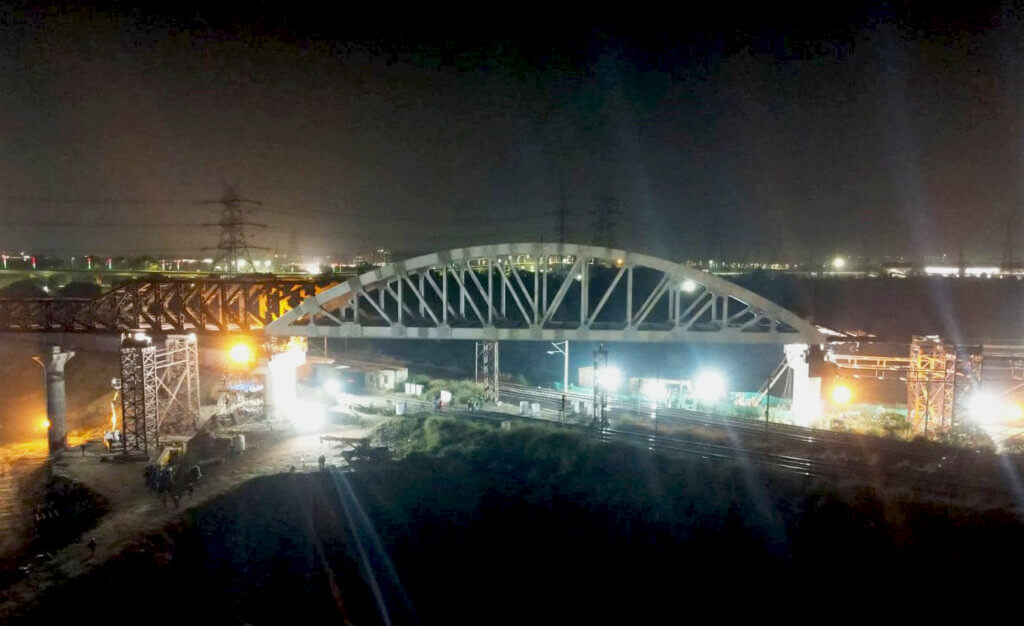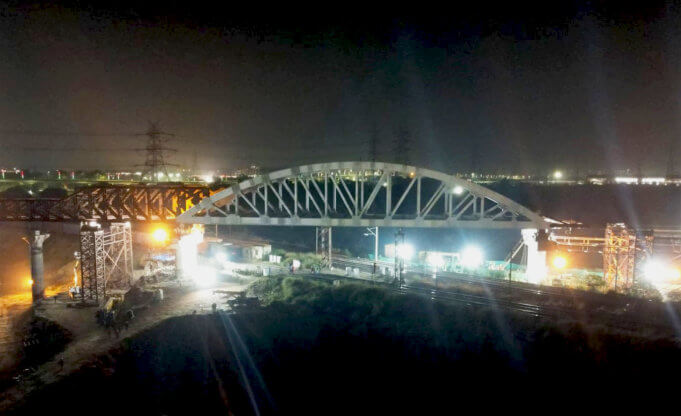 NCRTC has successfully completed the installation of the first special steel span of the Delhi-Ghaziabad-Meerut RRTS corridor over the mainline Indian railway crossing near Vasundhara, Ghaziabad. This special steel span is 73 meter long and weighted around 850 tonnes. It has been installed on the piers of about 10 metre height on both side of the Indian railway tracks by using winch and roller arrangement.
NCRTC has successfully completed the installation of the first special steel span of the Delhi-Ghaziabad-Meerut RRTS corridor over the mainline Indian railway crossing near Vasundhara, Ghaziabad. This special steel span is 73 meter long and weighted around 850 tonnes. It has been installed on the piers of about 10 metre height on both side of the Indian railway tracks by using winch and roller arrangement.
With the successful installation of this special steel span, another milestone has been achieved in the construction of India’s first RRTS corridor between Delhi to Meerut. This is the first special steel span of the 17 km priority section from Sahibabad to Duhai, which is targeted to be commissioned by the year 2023.
Another special steel span of around 150 meter is underway just before the Ghaziabad RRTS Station where under construction RRTS viaduct is crossing over a road flyover and Delhi Metro viaduct together.
NCRTC has completed the installation of this special steel span with all safety measures with full cooperation of the Northern Railway. The whole process of movement of this special steel span over Indian Railway tracks was completed within the specified blocks with minimum disruption.
In the installation process of this huge special steel span, first the whole steel structure is fabricated near the actual location on the trestle which is a framework consisting of beams. After the complete structure is ready, it is to be moved on rollers towards the piers erected on both sides. This is a very challenging and complicated process considering the high weight of the steel structure.
The fabrication of these special steel spans is so fine that they don’t need any finishing post-installation. Post this installation, the next phase of track laying and OHE installation can be carried out immediately.
For the construction of the elevated viaduct of the RRTS corridor, NCRTC is erecting piers generally at an average distance of 34 meters. Post this, these piers are joined by pre-cast segments with the help of launching gantries (तारिणी) to construct a RRTS viaduct span. However, maintaining this distance between piers is not practically possible in some complex areas where the corridor is set to cross over rivers, bridges, rail crossings, metro corridors, expressways, or other such existing infrastructure.
To connect piers in such areas, Special Spans are being used. Special Spans are mammoth civil structures having beams made of structural steel. NCRTC is building Special Spans made of structural steel at a factory which is then transported to the sites on trailers during the night to avoid any traffic problems and assembled in a systematic way with help of specialized process. The size and structure of these steel spans are designed aesthetically in advance, in-line with the overall requirements of construction, installation, and usage.
More than 14,000 workers and 1100 engineers are working tirelessly on the 82 km long RRTS corridor where in more than 1100 piers of the elevated section have been erected, more than 50 km of foundation work and approximately 14 km of viaduct have been completed, most of which is located in the priority section.
Along with the construction of the viaduct in the priority section, the construction work of all five stations – Sahibabad, Ghaziabad, Guldhar, Duhai, and Duhai depot is in advanced stages. Track laying work is going on by connecting rail tracks on the viaduct between Ghaziabad to Duhai.
NCRTC team is working day and night at the sites with 18 launching gantries (तारिणी) in operation for the elevated section in the corridor. The construction work for the underground section has also started where the Tunnel Boring Machine launching shafts are being constructed.
NCRTC has managed the pace of the construction while simultaneously taking extensive pollution control measures in and around the construction sites. A dedicated team of experts are regularly monitoring the effectiveness of these measures and step-up the activities wherever necessary. Construction work is being done within barricaded zones of adequate height and thorough cleanliness is being maintained on these sites. Anti-smog guns, water sprinklers are deployed to settle the construction dust. All the raw materials, debris are kept covered at their marked sites.











